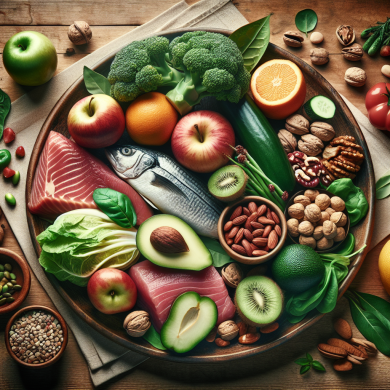### Paleo Triumphs: Inspiring Weight Loss Journeys
“`html
Paleo Triumphs: Inspiring Weight Loss Journeys
The pursuit of a healthy lifestyle often leads individuals down various dietary paths, each promising its own set of benefits. Among these dietary regimens, the Paleo diet has garnered significant attention for its back-to-basics approach, reminiscent of the eating habits of our Paleolithic ancestors. This article delves into the essence of the Paleo diet, its potential benefits, and inspiring stories of individuals who have embarked on their own Paleo journeys toward weight loss and improved health.
The Essence of the Paleo Diet
The Paleo diet, also known as the Paleolithic or Caveman diet, is founded on the principle of consuming foods that our hunter-gatherer ancestors would have eaten. The central tenet is to eliminate processed foods and focus on whole, unprocessed ingredients that our bodies are naturally adapted to digest. Advocates of the Paleo diet argue that modern diets, high in refined sugars, grains, and processed foods, contribute to many of today’s health issues, including obesity, diabetes, and heart disease.
The core components of the Paleo diet include:
– **Lean Proteins:** Emphasizing meats such as grass-fed beef, free-range poultry, and wild-caught fish.
– **Fruits and Vegetables:** Prioritizing a variety of fresh produce, which provides essential vitamins, minerals, and antioxidants.
– **Nuts and Seeds:** Offering healthy fats and protein, nuts and seeds are a staple in the Paleo diet.
– **Healthy Fats:** Sources include avocados, olive oil, and coconut oil.
– **Avoidance of Grains and Legumes:** Based on the belief that these foods contain anti-nutrients that can interfere with nutrient absorption.
– **Exclusion of Dairy and Refined Sugars:** These are considered modern additions to the human diet that may contribute to various health issues.
Paleo Diet and Weight Loss
The Paleo diet’s emphasis on whole, nutrient-dense foods naturally leads to lower calorie consumption, which can contribute to weight loss. By focusing on protein and healthy fats, the diet promotes satiety and reduces hunger, making it easier for individuals to consume fewer calories without feeling deprived. Moreover, the elimination of processed foods reduces the intake of empty calories and added sugars, which are often linked to weight gain.
Several studies have supported the weight loss potential of the Paleo diet. For instance, research published in the European Journal of Clinical Nutrition found that participants following a Paleo diet experienced greater weight loss and reduced waist circumference compared to those on a typical low-fat diet. Another study in the Journal of Internal Medicine reported that the Paleo diet led to significant improvements in body weight, waist circumference, and body mass index (BMI) over a short period.
Inspiring Paleo Weight Loss Journeys
While scientific evidence supports the efficacy of the Paleo diet for weight loss, personal stories of triumph can often provide the most compelling motivation. Here are some inspiring journeys of individuals who have transformed their lives through the Paleo lifestyle.
Emma’s Transformation: From Desk Job to Dynamic Lifestyle
Emma, a 35-year-old marketing executive, spent most of her waking hours sitting at a desk. Over the years, she noticed her weight creeping up, and she struggled with low energy levels and frequent digestive issues. After researching various diets, Emma decided to try the Paleo diet, intrigued by its emphasis on whole foods.
Within weeks, she noticed significant changes. Her energy levels soared, and her digestive issues subsided. Over the course of a year, Emma lost 30 pounds and discovered a newfound love for physical activity. She began participating in local 5K runs and eventually completed a half-marathon. Emma credits the Paleo diet for not only helping her shed pounds but also transforming her mindset toward food and exercise.
James’ Journey: Battling the Bulge with Paleo
James had struggled with his weight since childhood, bouncing from one diet to another without lasting success. Frustrated and determined to make a change, he decided to commit fully to the Paleo diet. The transition was challenging at first, particularly giving up bread and pasta, staples of his previous diet.
However, James quickly adapted, experimenting with new recipes and discovering the joy of cooking. He found that the Paleo diet’s focus on protein and vegetables left him feeling satisfied and less inclined to snack between meals. Over the course of two years, James lost over 100 pounds and gained a new lease on life. His journey inspired him to become a certified health coach, helping others navigate their own health transformations.
Laura’s Leap: A Family Affair
For Laura, a busy mother of three, adopting the Paleo diet was initially a family experiment to address her husband’s health concerns. However, the changes benefited the entire family. Laura was surprised by how quickly her children adapted to the new way of eating and how much they enjoyed the meals.
For Laura, the most significant change was her own weight loss. Within six months, she lost 40 pounds and experienced improved mental clarity and mood. Encouraged by the positive changes, Laura began blogging about her family’s Paleo journey, sharing recipes and tips with a growing online community. Her story has inspired countless families to embrace healthier eating habits together.
Challenges and Considerations
While the Paleo diet has garnered praise for its potential to promote weight loss and improve overall health, it is not without its challenges. Transitioning to a Paleo lifestyle requires significant dietary changes, which can be daunting for some individuals. Common challenges include:
– **Eliminating Grains and Dairy:** Removing staple foods like bread, pasta, and dairy products can be difficult for many people. Finding suitable alternatives and adapting to new flavors and textures is often necessary.
– **Social Situations:** Dining out or attending social gatherings can be challenging when adhering to a strict Paleo diet. Planning ahead and finding Paleo-friendly options is key.
– **Nutrient Considerations:** The exclusion of certain food groups, such as dairy and grains, may lead to deficiencies in calcium and fiber. It is essential to ensure a balanced intake of nutrients through other sources.
– **Cost and Accessibility:** Sourcing high-quality, organic ingredients can be expensive and may not be accessible to everyone. Finding cost-effective ways to follow the Paleo diet is important for long-term sustainability.
Conclusion: Embracing the Paleo Lifestyle
The Paleo diet’s emphasis on whole, unprocessed foods resonates with many individuals seeking to improve their health and achieve weight loss. While scientific evidence supports its effectiveness, personal stories of transformation provide powerful inspiration. Emma, James, and Laura’s journeys illustrate the potential of the Paleo diet to not only facilitate weight loss but also foster a holistic approach to health and well-being.
For those considering the Paleo diet, it is crucial to approach the transition with an open mind and a willingness to experiment. Embracing the principles of the Paleo lifestyle can lead to profound changes in one’s relationship with food and body. Ultimately, the success of the Paleo diet lies in its ability to empower individuals to take control of their health and embark on their own journeys toward transformation and triumph.
“`















Add comment